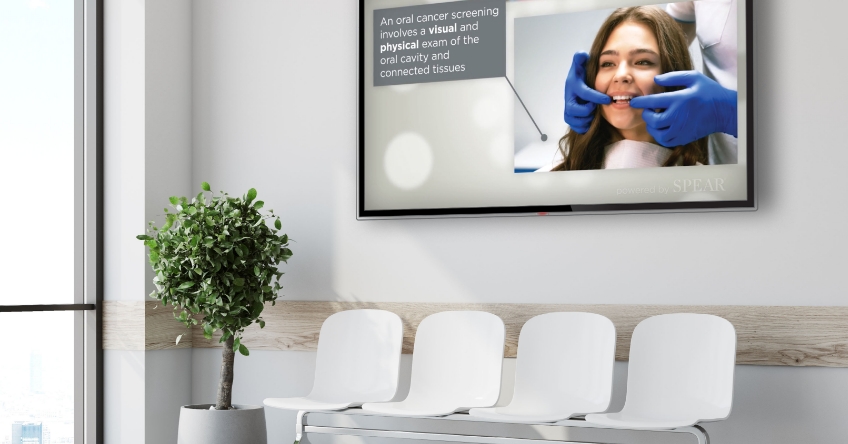5 Dental Office Design Tips to Put Patients and Team Members at Ease
While it is easy to get caught up in trendy dental office design tips, the key to creating a successful practice lies in prioritizing patient comfort and satisfaction. By focusing on elements such as a streamlined check-in process, carefully curated color schemes, augmented reality features, patient education programs, and engaging room themes, you can help your patients feel more relaxed and enable your staff to work more efficiently.
Up to 16% of US adults suffer from dental anxiety so severe that it can be qualified as a phobia. While their treatment matters a great deal in alleviating those concerns, so does the design of your office. With a few changes, you can help to reduce that anxiety and encourage proper treatment.

1. Innovate your check-in process
In 2019, nearly half of US adults reported delaying dental care due to the pandemic. Dental waiting rooms can be anxiety-inducing in and of themselves. Add in the risk of a deadly virus, and you create a perfect storm where patients don’t get the care they need.
By updating your check-in process to make it more digitally forward and streamlined you can eliminate that anxiety and shorten waiting room time.
Here are a few tools to consider implementing;
- Online scheduling
- Patient portals
- Mobile check-in
- Digital forms
- E-signatures
- Self-check-in kiosks
- Facial recognition check-in
- Virtual waiting rooms
- SMS notifications
- Video chat check-in
- Electronic payments
- Electronic health records
- Practice management software
- Interactive education software
- Online prescriptions
- Health tracking apps
- Telemedicine consultations
- Patient satisfaction surveys
- Queue management software
2. Tell a color story
Telling a color story is about more than slapping some paint on the walls. It is about selecting a palette of colors that work together to create a cohesive look and feel throughout the space. It can even be used to transition somebody from one area to the next.
For example, an office might use muted browns and earth tones in their waiting area and then transition that into greens and blues in their exam room. When done properly, the color can evoke certain emotions and help guide patients from one end of the office to another.
 | This color is often associated with passion, love, and energy. On the negative side, it can also evoke feelings of anger or danger. |
 | Orange is often used to show warmth, enthusiasm, and creativity. However, it’s also connected to frustration and frivolity. |
 | Yellow may indicate happiness, optimism, and energy. On the other side, it may also indicate anxiety or caution. |
 | Green is often connected with nature, health, and tranquility. It is also famously associated with envy and greed. |
 | Blue is the color most often used to indicate calmness, trust, and security. This soothing hue may also trigger feelings of sadness or coldness. |
 | Purple conveys an air of luxury, being the official “color of royalty.” Unfortunately, it can also come off as arrogant or moody. |
 | Brown is often used to attribute earthiness, stability, and simplicity. It is also seen as a dull or heavy color. |
 | Gray is often associated with neutrality, sophistication, and professionalism. It may also evoke feelings of emptiness or isolation. |
The key to a cohesive color story and balance is to consider those emotions. A pop of purple or red on a gray background can help balance out the aggression of the first colors while adding a touch of spice to the neutrality of the second. Experiment with color palettes to find a design that suits you and your team.

3. Incorporate patient education programming
Patient education videos can be an informative, engaging, and low-stress way to explain procedures to your patients in a way that they understand. You can use these in your lobby or your exam room to prepare patients for treatment.
Of course, you’ll want to select a lobby TV with your patients. There should be videos suitable for children, adults, and seniors that explain dental procedures, oral hygiene, and overall health.
This helps because patients can often feel anxious about dental procedures. Loading lobby TVs with patient education programming can ease their concerns by providing them with a better understanding of the procedures they may undergo.
4. Consider adding AR elements
AR stands for augmented reality, and it can be utilized in various ways within your dental office. From helping you design the layout in the first place to creating a soothing and immersive experience for patients, there are numerous AR tools available to help you enhance patient care. Here are just a few ways that AR can be incorporated into your dental office design.
- Visualize office design: Designers can use AR to create virtual 3D models of the office space, which can be viewed through a mobile device or headset. This allows them to see how the design will look and feel in real time and adjust, as necessary.
- Highlight equipment and technology: AR can be used to showcase dental equipment and technology in a virtual environment. This allows patients and dental team members to see and interact with the equipment before it is installed in the office.
- Patient education: AR can be used to improve patient education by providing interactive, 3D visualizations of dental procedures. Patients can use their mobile devices to view the AR model and gain a better understanding of the procedure, which can help reduce anxiety and improve treatment outcomes.
- Enhance office signage: These tools enhance office signage by creating interactive displays that provide additional information about the office, services, and procedures. Patients can use their mobile devices to scan the signage and access the additional information, which can help improve their overall experience.
- Streamline equipment placement: AR can be used to streamline equipment placement by creating virtual models of dental equipment and testing different placement options in a virtual environment.
AR can be a valuable tool in dental office design, whether you are laying out the workspace or using it as an element. It can also be used as a tool for the next tip — creating themes for your rooms.
5. Consider a theme
We most often see room themes incorporated into pediatric dentistry. These dentists may create rooms around circus or space themes to help put their young patients at ease. But why not update that for your adult patients as well? Different themes can be used to evoke feelings of serenity and make patients more comfortable during treatment.
A beach theme might be a good example. Using calming blue and green colors along with decor like seashells, starfish, or paintings of the ocean can create a seaside escape in your dental office. To make the experience even more immersive, you may consider adding the sounds of ocean waves or sea life.
If sophistication is your goal, a modern, minimalist theme might be the choice for you. Neutral colors, such as white, gray, and black, can create a clean and straightforward appearance. Consider including contemporary art to add an interesting element to the room. The point is that themes don’t have to be just for pediatric patients. Think of the places that put you at ease and consider how you can bring that environment into your dental office.

How design improvements help your dental team
The dental office design tips listed above actually have a dual purpose. While every single one of them puts your patients at ease, they also improve life for your dental team.
- Streamlined check-in: The process of checking in a patient is predictable, repeatable, and high volume. Computer software can automate these tasks so your dental team can focus on more critical, complicated needs.
- Improved mood: If you think sitting in a gray office with no windows for a few hours would be boring for your patients, imagine how terrible it would be for staff working there 40 hours a week. Improving your color palette can also improve their morale. Of course, make sure to get your team’s feedback before making changes.
- Prepared patients: Patient education programming is a great tool because it gives the patients the base information that they are going to need without your dental assistants or hygienists having to repeat the same details over and over again.
- Ergonomic improvements: Augmented reality technology can be used to improve the ergonomics of your office, whether you are evaluating how instruments can be made easier to reach or how technology can be improved to eliminate uncomfortable tasks.
- Organized by design: The use of themes is not just a fun element — it also makes rooms quite easy to identify. Someone who was told to go to “exam room 3” may not know their way. Someone told to go to “the ocean room” will know exactly where that is.
When it comes to dental office design tips, the key is to prioritize patient comfort and well-being. While flashy features may seem appealing, it is essential to focus on elements that put patients at ease. This includes paying attention to color schemes, streamlining the check-in process, and providing informative and educational materials. Incorporating augmented reality and fun themes can also be an effective way to engage patients. By implementing these design tips, you’ll not only create a more relaxing environment for your patients but also a happier dental team.
SPEAR NAVIGATOR
Transform how your practice runs by engaging the team through
coaching and training
A guided path to excellence through structured coaching and self-guided resources that will align your team, streamline processes and drive growth. Transform your practice by implementing Spear’s proven playbooks for developing and retaining a high-performing dental team.

By: Spear Team
Date: October 17, 2023
Featured Digest articles
Insights and advice from Spear Faculty and industry experts


